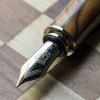Search the Community
Showing results for tags 'eye-dropper'.
-
Dazzled by the resplendent allure of a Japanese ED (with the concept of a shut-off valve mechanism), the lust for an urushi lacquered pen vis-a-vis plain ebonite ones (seemingly susceptible to lose shine and colour over time) did keep growing on me for some time, before I took this plunge! I have co...
- 152 replies
-
Hello Everyone Its an intimidating task to write something about the famed Gem & Co. from Chennai, the creator and seller of some truly world class Indian fountain pens since 1920s. That's enough time for the world to spin a lot around its axis, witnessing rise and fall of different eras and trend...
-
Some months back, I had written a review titled "Fountain Pen Revolution in India" There I had written that "...it is good that ASA is making its own revolutionary contribution in making of the high standard fountain pen in a substantive manner." And it is good to see that ASA is scaling up on the s...
-
I am wondering why eye-dropper pens seem to be so common from India? I that the main pen style used there or just the main type for export? Thanks for any info you can provide. Dave
- 10 replies
-
- ed
- eye-dropper
-
(and 1 more)
Tagged with:




